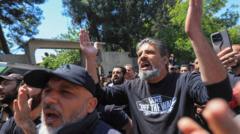In the wake of escalating violence in Syria, the Druze community finds itself grappling with an alarming new reality. The recent surge in sectarian violence, specifically targeting the Druze people, has sowed seeds of fear and mistrust among their ranks, particularly following a gunfire incident in the Damascus suburb of Ashrafiyat Sahnaya. Shedding light on her traumatic experience, Lama al-Hassanieh recalled locking herself in her bathroom as armed men strolled menacingly in military attire outside her home, shouting threats at her community.
The Druze, a community rooted in a faith that diverges from Shia Islam, have historically maintained a delicate balance in Syria's complex sectarian landscape. Loyalty to the Assad regime was seen as a method of self-preservation amid rampant violence. Though many Druze took to the streets during protests against the government, Assad's tactics leaned toward preserving the Druze’s safety, ensuring they were less likely to face the brunt of violent crackdowns seen in other sects.
However, the arrival of a Sunni Islamist-led interim government has unsettled the Druze. Reports of violent attacks, including a barrage of sectarian rhetoric fueled by a falsified audio recording of a Druze leader, have led to widespread violence. The Syrian Observatory for Human Rights documented the deaths of over 137 individuals, including civilians and security personnel, during the subsequent chaos.
Among the affected was pharmacy student Lama Zahereddine, who narrowly escaped a direct assault on her village, witnessing a complete breakdown of security. In one harrowing encounter, her university dormitory was stormed, and fellow Druze students were brutally attacked.
The situation has left many feeling abandoned, with students like Lama experiencing mockery from classmates instead of support, deepening the sense of isolation. Widespread distrust toward government assurances of protection is rampant. Residents feel that promises of safety have failed to materialize, leading to demands for accountability for the attacks that have shattered their communities.
Without clarity on who is instigating the violence, the Druze community stands on alert, persisting under a looming shadow of a potential sectarian order that threatens to render them voiceless in their homeland. In light of these challenges, members like Hadi Abou Hassoun have taken up arms to protect their neighborhoods amidst calls for state accountability.
As clashes have quelled for now, the long-term implications of distrust and fear remain significant. Many Druze, including al-Hassanieh, reflect on a community deeply fractured, where the lines of belonging have blurred, leaving them to question their status as citizens in their own country. Calls for unity among all Syrians resonate, yet the specter of fear continues to linger over their rights and safety.
The Druze, a community rooted in a faith that diverges from Shia Islam, have historically maintained a delicate balance in Syria's complex sectarian landscape. Loyalty to the Assad regime was seen as a method of self-preservation amid rampant violence. Though many Druze took to the streets during protests against the government, Assad's tactics leaned toward preserving the Druze’s safety, ensuring they were less likely to face the brunt of violent crackdowns seen in other sects.
However, the arrival of a Sunni Islamist-led interim government has unsettled the Druze. Reports of violent attacks, including a barrage of sectarian rhetoric fueled by a falsified audio recording of a Druze leader, have led to widespread violence. The Syrian Observatory for Human Rights documented the deaths of over 137 individuals, including civilians and security personnel, during the subsequent chaos.
Among the affected was pharmacy student Lama Zahereddine, who narrowly escaped a direct assault on her village, witnessing a complete breakdown of security. In one harrowing encounter, her university dormitory was stormed, and fellow Druze students were brutally attacked.
The situation has left many feeling abandoned, with students like Lama experiencing mockery from classmates instead of support, deepening the sense of isolation. Widespread distrust toward government assurances of protection is rampant. Residents feel that promises of safety have failed to materialize, leading to demands for accountability for the attacks that have shattered their communities.
Without clarity on who is instigating the violence, the Druze community stands on alert, persisting under a looming shadow of a potential sectarian order that threatens to render them voiceless in their homeland. In light of these challenges, members like Hadi Abou Hassoun have taken up arms to protect their neighborhoods amidst calls for state accountability.
As clashes have quelled for now, the long-term implications of distrust and fear remain significant. Many Druze, including al-Hassanieh, reflect on a community deeply fractured, where the lines of belonging have blurred, leaving them to question their status as citizens in their own country. Calls for unity among all Syrians resonate, yet the specter of fear continues to linger over their rights and safety.




















